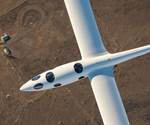Perlan 2 glider launches new season of operations
The carbon fiber and fiberglass aircraft will be deployed to Patagonia later this year, with the aim of achieving the world altitude aviation record for sustained, level flight.
Airbus Perlan Mission II on May 15 announced the launch of its fourth season of operations with a press briefing at Minden-Tahoe Municipal Airport (Minden, Nev., U.S.), the year-round home of the Perlan 2 glider, the world’s first engineless aircraft designed to reach the edge of space. The carbon fiber and fiberglass aircraft will be deployed to Patagonia later this year, with the aim of achieving the world altitude aviation record for sustained, level flight.
Last year, on Sept. 2, 2018, the Airbus Perlan Mission II team set a new world record of 76,124 feet pressure altitude, surpassing the highest known flight of the U-2 spy plane (74,000 feet). This year, the team wants to soar the Perlan 2 space glider up to its maximum altitude of 90,000 feet, using only the power of the wind in the stratosphere to soar.
“We’re excited to be supporting this courageous group of aviation pioneers, whose passion and drive for innovation really epitomizes the spirit we try to instill in everyone at Airbus,” says C. Jeffrey Knittel, chairman and CEO of Airbus Americas, title sponsor of the non-profit project. “We look forward to the contributions to our industry that this project will make this year, and are proud to have our name on such a history-making aircraft.”
The Airbus Perlan Mission II team has reportedly made key technological innovations and improvements to the aircraft since its last season. The aircraft’s capabilities include a visualization system for seeing rising air currents in the cockpit; spacecraft-capable oxygen rebreathers; a drogue parachute to allow rapid descent in case of emergency; and a ballistic chute for a lower-altitude emergency descent.
The glider’s true flight speed at its maximum altitude of 90,000 feet is said to be almost 400 miles per hour. A passive pressurization system protects the crew in an environment where the air density is less than two percent of what it is at sea level.
The Perlan 2 glider will begin its two-month shipping voyage to Argentina in June, and by the end of July the Airbus Perlan Mission II team will have relocated its operations to the Patagonian town of El Calafate. Atmospheric conditions in the region allow the team to soar into the stratosphere on rising air currents, yielding new discoveries related to high-altitude flight, weather and climate change.
Related Content
-
The next-generation single-aisle: Implications for the composites industry
While the world continues to wait for new single-aisle program announcements from Airbus and Boeing, it’s clear composites will play a role in their fabrication. But in what ways, and what capacity?
-
Cutting 100 pounds, certification time for the X-59 nose cone
Swift Engineering used HyperX software to remove 100 pounds from 38-foot graphite/epoxy cored nose cone for X-59 supersonic aircraft.
-
Otto Aviation launches Phantom 3500 business jet with all-composite airframe from Leonardo
Promising 60% less fuel burn and 90% less emissions using SAF, the super-laminar flow design with windowless fuselage will be built using RTM in Florida facility with certification slated for 2030.
















